Note: This review encompasses the first three episodes of WandaVision, the first two of which will debut this week on Disney+. We have been asked by the studio to avoid story specifics where at all possible.
Can you believe it’s been over a year since we’ve had any Marvel Studios content at all? In the scheme of things, who cares, of course. There’s a world changing pandemic that continues to alter every aspect of our daily lives. But it does feel a little odd when one of these Kevin Feige produced thrill-rides hasn’t been in our mindspaces at least once within 12 months, much less 18. One day, Black Widow and Eternals, both pushed back a year, will indeed come out; but in the meantime, Hollywood’s most powerful ballcap wearer and his cohorts at Disney made a very shrewd move to segue much of the MCU into the streaming space. Given everything, and the precarious future theatrical exhibition may be facing, their timing couldn’t have been better.
WandaVision marks the first effort of this newly expansive MCU slate on Disney+, and a bit of a fresh start for Marvel on television in general. All that gritty, lesser Netflix stuff presumably doesn’t count anymore, and instead we’re getting shows focused on all the Avengers big guns and much bigger budgets. Given the rapturous reception that The Mandalorian got from fandom and general audiences, pushing the MCU into this longer form arena seems like the safest bet of all time, really.
The further adventures of Wanda Maximoff, post-Avengers: Endgame, one of the more intriguing angles to be followed up on from that blockbuster with a capital “B”, was originally supposed to be the second debuting series of this lineup. But after COVID-19 related production delays slowed Falcon and The Winter Soldier’s filming, this oddball Jac Schaeffer led joint was pushed to the fore. It’s a bit of a strange starting point, though perhaps it’s fitting in that its sitcom pastiche aesthetic draws a firm line between the all-action, all-the-time approach of the films, and Feige’s ongoing goal of trying to “do new things” within the studio’s somewhat restrictive framework. To put it gracelessly, television can allow for more flexibility, as there’s ideally less of a four-quadrant approach that needs to be adhered to.
Of course, there’s some potential for built-in flaws too, but we’ll get there.
If you’ve seen a trailer for WandaVision, you pretty much know the pitch. Scarlet Witch/Wanda (Elizabeth Olsen) is, post-defeat of Thanos/death of Vision, living in a reality that resembles a 1950’s sitcom. She lives in a blissful, Stepford-home, acting as an idealized homemaker for her husband Vision (Paul Bettany) who is a workaday guy in a firm that produces outcomes reports…for something. Their big secret is that they both still have their abilities, and their attempts to hide that lead to all sorts of comic hijinks, from cooking dinner for Vision’s boss (Fred Melamed, who will always be Sy Ableman to me), to performing at a community talent show, to staving off their nosy neighbor Agnes (Kathryn Hahn).
But something is amiss, and every once in a while, the fact that there’s a bit of a fracture in their reality creeps up. What is real? What is happening? How is Vision alive? What’s going on with Teyonah Parris’ character? It’s an intriguing set of questions that the show sets out to answer, and based on these first three chapters it seems like it’s going to take its own time doing it.
Surely the most attractive feature to WandaVision is its strict adherence to style above all. Its first episode, in full glorious monochrome, is reminiscent of I Love Lucy, including cooking shenanigans, and it even includes a commercial break for products that would be offered in the MCU at the time. Subsequent episodes evolve that approach, with the second outing echoing Bewitched, with Wanda and Vision’s personal styles moving forward towards the early 60’s with a fully animated title card that plays right into that comparison. The third continues that trend further on into Brady Bunch territory, complete with color. There’s clearly a lot of love here for classic television, and you really don’t need to understand the references, which are positively ancient now, to get what it’s doing. The first episode is particularly fun in a very authentically stagebound sort of way. It’ll throw the crowd that’s looking for high adventure for a loop probably, but it’s a neat change of pace.
Speaking of pace, that is a bit of the problem at the outset. While I quite like the concept itself, it really starts to wear thin pretty fast come the second episode, which centers itself on a mishap that leads to only a slightly amusing payoff. Though the bigger cardinal sin of that second installment is that very little actually happens, and when you only have nine episodes of total runway to work with, biding time seems like an unaffordable luxury. Thankfully, the third episode picks up the tempo somewhat, but it has a strange lopsided structure, a bit of a hybrid between the lackadaisical comedy of errors of the second episode and presumably where the rest of the series is likely headed.
There’s shreds of neat weirdness on the margins that’s appealing (though any comparisons to David Lynch are patently absurd), and Olsen and Bettany are always a pleasure to watch, but it’s hard to not be a little let down by the decompressed approach at its inception, given that was among the biggest problems facing the previous iteration of Marvel TV shows. Still, by the end of episode 3, I’m intrigued enough to want to know more. Enough to pay the regular subscription fee? Jury is still out on that one!

